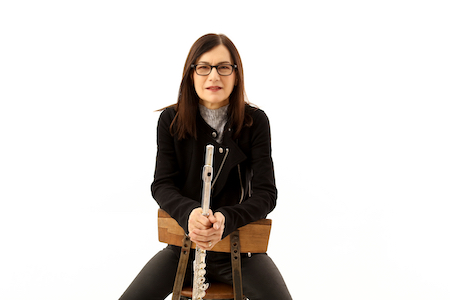Oct 28, 2025 10:47 AM
In Memoriam: Jack DeJohnette, 1942–2025
Jack DeJohnette, a bold and resourceful drummer and NEA Jazz Master who forged a unique vocabulary on the kit over his…

“It’s been my goal to write and record new types of opportunities for improvisation,” Jamie Baum says.
(Photo: Courtesy Jamie Baum)The Jamie Baum Septet breezed into Dizzy’s Club in New York this February premiering a variety of pandemic-inspired music.
Inspired by journalist Bill Moyers’ online series “A Poet A Day, Poetry for the Pandemic,” Baum premiered new music replete with crisscrossing odd meters, unusual ensemble phrases, challenging structures and homophonic melodic scenarios in dense arrangements that produced wonderful solos. Baum’s music was far from the typical head/solo/head/bridge/head reprise formula of much contemporary jazz, but rather, fresh music for flute and ensemble that opened new paths of improvisation and soling possibilities for her tightly knit, extremely well-tuned, sympathetic septet with Baum on flutes, Jonathan Finlayson on trumpet, Sam Sadigursky on alto saxophone and bass clarinet, Chris Komer on French horn, Brad Shepik on guitar and singing bowls, Luis Perdomo on piano, Ricky Rodriguez on acoustic/electric basses and singing bowls, Jeff Hirshfield on drums and guest vocalist Aubrey Johnson.
“I wanted to choose poems that would express, in a programmatic way, some of the things that we’re grappling with during COVID, what it’s like to be in the midst of things, how it’s affecting us and how we might learn from it and grow or emerge from it,” Baum said during a phone call a few days after the Dizzy’s performance.
Describing it as “programmatic music,” Baum’s new work exhibited a natural rise and fall, from intense ensemble passages to freer blowing sections.The high points came in the funky picking of Shepik, the streamlined, even creamy solos of Finlayson, the exhilarating perambulations of Perdomo, Baum’s subtle but intense playing on soprano and alto flutes (with use of octave and reverb pedals), and Hirshfield (Baum’s husband) providing the swinging glue that held it all together.
This diverse lineup, performing Baum’s highly evolved material, inspired potent, powerful solos. From Shepik’s avant leanings and Perdomo’s Afro-Cuban mastery to Rodriguez and Hirshfield’s flowing, driving accompaniment based in years of work on the New York jazz scene, the musicians consistently met the demands of Baum’s compositions.
“I like to put people together that have a similar concept in terms of openness and listening, but that have different styles, in a way, because I think that they can inspire each other and it makes the music more interesting to listen to,” Baum explained.
“The first tune, ‘In The Light Of Day,’ with the singing bowls, I wanted to give the impression of life going on in a big city, where things are frenetic and we’re not really taking time to smell the roses, so to speak. Just sort of going about our daily crazy life,” Baum said.
“‘To Be Of Use,’ by Marge Piercy, talks about the value of the simple life and how we’ve undervalued that. During the pandemic we valued the essential workers, the first-line workers. Workers in the grocery store or those delivering food, they became incredibly important,” Baum continued.
“In ‘An Old Story,’ by Tracy K. Smith, she wrote that as a new story for the 21st century, a moment characterized by great social and political division. The end of the tune gets brighter and happier sounding; it’s got two sections to it,” she added.
“‘Dreams,’ I wrote in honor of a cousin who passed. He fought a long battle with cancer and was very courageous. It begins with French horn and bass clarinet, then moves to the piano. The idea of finding courage and hope wherever you can. That’s part of what we’re dealing with now.
“Then two pieces by Adrienne Rich, where she notes how we’ve lost sight as a collective. The idea of people taking care of each other. ‘What Kind of Times Are These’ was inspired by a Bertolt Brecht poem. During the Nazi occupation, he wrote, ‘What kinds of times are these when it’s almost a crime to talk about trees?’ It’s about keeping silent about so many evil deeds.”
Baum writes for musicians and music lovers, compositions based in the past but not beholden to it, performed by musicians girded for exploration and challenge.
“It’s been my goal to write and record new types of opportunities for improvisation, and also to create a different platform for the way we hear the jazz flute,” Baum said. “A band using trumpet and bass clarinet and French horn gives the flute more weight, instead of having tenor sax and baritone. The musicians tell me they love the compositions; it’s well-written so that they feel challenged.” DB

Jack DeJohnette boasted a musical resume that was as long as it was fearsome.
Oct 28, 2025 10:47 AM
Jack DeJohnette, a bold and resourceful drummer and NEA Jazz Master who forged a unique vocabulary on the kit over his…

Goodwin was one of the most acclaimed, successful and influential jazz musicians of his generation.
Dec 9, 2025 12:28 PM
Gordon Goodwin, an award-winning saxophonist, pianist, bandleader, composer and arranger, died Dec. 8 in Los Angeles.…

Flea has returned to his first instrument — the trumpet — and assembled a dream band of jazz musicians to record a new album.
Dec 2, 2025 2:01 AM
After a nearly five-decade career as one of his generation’s defining rock bassists, Flea has returned to his first…

To see the complete list of nominations for the 2026 Grammy Awards, go to grammy.com.
Nov 11, 2025 12:35 PM
The nominations for the 2026 Grammy Awards are in, with plenty to smile about for the worlds of jazz, blues and beyond.…

Nov 13, 2025 10:00 AM
For results of DownBeat’s 90th Annual Readers Poll, complete with feature articles from our December 2025 issue,…







